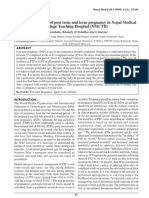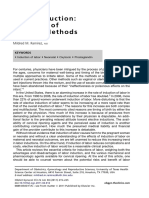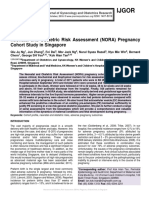Tercer Articulo Isa
Tercer Articulo Isa
Uploaded by
Isabel Cristina Castro SernaCopyright:
Available Formats
Tercer Articulo Isa
Tercer Articulo Isa
Uploaded by
Isabel Cristina Castro SernaCopyright
Available Formats
Share this document
Did you find this document useful?
Is this content inappropriate?
Copyright:
Available Formats
Tercer Articulo Isa
Tercer Articulo Isa
Uploaded by
Isabel Cristina Castro SernaCopyright:
Available Formats
Rev Sade Pblica
Joyce Green KoettkerI Odala Maria BrggemannII Rozany Mucha DuothIII Roxana KnobellV Marisa MonticelliII
Outcomes of planned home birth assisted by nurses, from 2005 to 2009, in Florianpolis, Southern Brazil
ABSTRACT
A cross-sectional study was performed to analyze obstetric and neonatal results of planned home births assisted by obstetric nurses in the city of Florianpolis, Southern Brazil. Data collected from the medical records of 100 parturient women cared for between 2005 and 2009 indicated 11 hospital transfers, nine of which underwent a Cesarean section. The majority of women who had a home birth showed normal fetal heart beat (94.0%) and progress on the partogram (61.0%), vertical water delivery was the position most frequently chosen (71.9%), newborns had an Apgar score 7 at ve minutes (98.9%), episiotomy was performed in 1.0%, and 49.4% did not need perineal suturing. Outcomes indicated that planned home birth is safe. DESCRIPTORS: Home Childbirth. Humanizing Delivery. Natural Childbirth. Nurse Midwives. Obstetrical Nursing.
Maternidade Carmela Dutra. Florianpolis, SC, Brasil Departamento e Programa de PsGraduao em Enfermagem. Centro de Cincias da Sade (CCS). Universidade Federal de Santa Catarina (UFSC). Florianpolis, SC, Brasil Departamento de Patologia, Programa de Ps-graduao em Patologia. Faculdade de Medicina. Universidade Estadual Paulista Jlio de Mesquita Filho. Botucatu, SP, Brasil Departamento de Ginecologia e Obstetrcia. CCS-UFSC. Florianpolis, SC, Brasil
INTRODUCTION Home birth is an option in several countries such as Canada,3 Australia5 and the Netherlands.4 International publications have shown that planned, assisted home births are as safe as hospital births.3,4 The American College of Obstetricians and Gynecologists (ACOG) does not support home birth programs because of an increased risk of neonatal deaths compared to hospital births, even though it is low and home births need less interventions.2 Planned home births are growing in urban centers in Brazil.1 The increasing number of home births in the southern city of Florianpolis may be attributed to the work of nurse-midwives of the Hanami Team Blossom (Flowering of life) planned home birth.a Evaluation of obstetric and neonatal outcomes of planned home births in Brazil is difcult since data from the Brazilian Live Births Database (SINASC) merge both planned and unplanned non-hospital births. There is a need to systematically assess non-hospital birth care to generate indicators. The present study aimed to evaluate obstetric and neonatal outcomes of planned home births attended by nurse-midwives.
a
II
III
IV
Correspondence: Joyce Green Koettker Rod. Admar Gonzaga, 841 Apto 917 bloco A Itacorubi 88034-000 Florianpolis, SC, Brasil E-mail: joycegreenk@yahoo.com.br Received: 7/18/2011 Approved: 2/10/2012 Article available from: www.scielo.br/rsp
Feyer ISS, Silva J, Koettker JG, Calvette MF, Burigo RA, Collao VS. O orescer da vida: parto domiciliar planejado, orientaes para gestao, parto e ps-parto. Florianpolis: Lagoa; 2009.
Outcomes of planned home birth
Koettker JG et al
METHODS Retrospective cross-sectional study carried out with a sample comprising all women and their newborns who had planned home births assisted by nurse-midwives of the Hanami Team between January 2005 and December 2009 in the city of Florianpolis. The team staff comprises three nurse-midwives and four nurse generalists and two obstetricians that eventually monitor women from early prenatal care. Women with low-risk pregnancies are screened using a protocol. Private care is provided. Nurses provide prenatal care on a weekly basis from week 37 of pregnancy to birth. On the day of delivery, the team staff comes to a pregnant womans home with basic medical emergency equipment for the event of complications including basic life support equipment. The new mother and her newborn are followed up on Day 1, 3, 4, and 10 postpartum.a The study sample and variables were obtained from nursing records of the care provided. Data were collected using a standardized questionnaire and entered into EpiInfo 2008. The data were analyzed through the application of descriptive statistical analysis (frequency and percentage). The study followed the principles of the Helsinki Declaration and Resolution 19696. It was approved by the Research Ethics Committee of the Universidade Federal de Santa Catarina (Protocol #552 on December 14, 2009). RESULTS Of 102 women who had planned home births assisted by nurses, 100 met the study inclusion criteria. Of these, 11 were transferred to a care facility during labor, and nine had Cesarean deliveries. The median age of the women was 28 years (range 21-43 years). Most (53) were college-educated and primiparous (73). Nine women had prior Cesarean sections and, of them, ve had home births. Being free to walk, move and eat was a principle of childbirth care. Amniotomy was done is eight women during labor. There were no changes in fetal heart rates in 94 cases and partograph during labor was normal in 61 cases. The time elapsed between the rst monitoring and childbirth was less than ve hours in 46 cases (Table). Women were supported by companions during childbirth; 60 of them had more than one companion and 98 were supported by their male partners. Water childbirth in the vertical position was the most common choice. Almost half of the women did not
Table. Obstetric and neonatal care in planned home
births. Florianpolis, Brazil, 2005-2009. (n = 89)
Variable Duration of dilation/expulsion 5 min to 4 hours and 59 min 5 hours to 9 hours and 59 min 10 hours to 14 hours and 59 min 15 hours to 19 hours and 59 min Delivery position Vertical water position Non-water vertical/side-lying or Sims position Meconium-stained aminiotic uid Perineum No laceration and no suturing 44 42 1 2 89 63 24 2 74 8 7 1 1 88 1 81 7 18 70 1 49.4 64 25 7 41 27 16 5 n %
46.1 30.3 18.0 5.6 71.9 28.1 7.0
First-degree perineal laceration and suturing
Episiotomy
47.2
1.1
Missing information
Skin-to-skin contact Breastfeeding within the rst hour of life Yes No Missing information Medication after giving birth None
2.2 100.0 70.8 27.0 2.2
83.1
Oxytocin
Others Missing information 5-min Apgar <7 7 Newborn classication Small for gestational age
8.9 7.9 1.1 1.1 98.9
1.1 91.0
Adequate for gestational age Large for gestational age
Capurros gestational age criteria 37 to 38 weeks
7.9
20.2 78.7
39 to 41 weeks > 42 weeks
1.1
need require perineal suturing. All newborns were placed in skin-to-skin contact on their mothers chest immediately after birth and 70.8% showed effective breastfeeding within the rst hour of life (Table). Of all newborns born at home, the median weight was3,300 g (2,470-4,300 g). Only one newborn showed a 5-min Apgar score lower than 7 but the newborn had
Rev Sade Pblica
a fast recovery after care was provided. One newborn was moved to a health facility after the birth because of epidermolysis bullosa that went undiagnosed in prenatal care. Other obstetric and neonatal variables are described in the table. DISCUSSION The neonatal and obstetric outcomes described in this study are similar to those reported in studies conducted in countries where home birth assisted by midwives is a well-recognized and respected care practice. In the sample studied maternal transfer rate was lower than that reported in other studies,1,3,5 and neonatal transfer and Cesarean rates1,5 were similar. The number of women with history of prior cesarean sections who gave birth at home was greater than that found in the international literature.5 The age range of low reproductive risk and high schooling of the women in the sample are similar to other samples studied in Brazil and worldwide.1,3-5 The proportion of primiparous women was higher than that reported in international studies,3-5 but similar to that reported in a study in So Paulo, Brazil, and it may suggest a common feature of Brazilian women who seek home birth care.1 Labor data in this study are consistent with a Canadian study3 showing non-drug management options and low amniotomy rates. In our study amniotomy was only performed when indicated (i.e., no advancing cervical dilation and curve crossing the alert line in the partograph). However, both rates were signicantly lower than those seen in hospital settings and maternity centers in Brazil.b The nding of labor duration greater than ve hours can be attributed to a high number of primiparous women and women who were in the latent phase at the beginning of labor monitoring. Yet, labor duration was shorter than that described in a Brazilian Ministry of Health report.c
In the home environment women were supported by more than one person from their social network, including their children, which helps strengthening family ties. Non-compliance of health facilities with the law of birth companionsd may be a reason motivating the choice of home birth. Women could choose their preferred positions during labor and during the stage of expulsion. There are scarce data, but women who are assisted at home apparently choose non-lithotomy positions in childbirth.1 With respect to childbirth outcomes, the rate of meconium-stained uid was low, which may be associated with high Apgar scores ( 7). Only one newborn required to be transferred to a neonatal intensive care unit, but it was not related to the care provided. The low episiotomy rates found were similar to those reported in other studies carried out in Brazil,1 Canada,3 and Australia.5 In contrast, episiotomies were performed in 70% of vaginal deliveries in hospital settings in Brazil in 2006.d Avoiding unnecessary interventions during labor may have contributed to good obstetric and neonatal outcomes. Some limitations of the study are the retrospective data collection and small sample size. In addition, there may be a potential bias as women chose to have home births because they felt empowered and sought non-interventive care. Our data were mostly compared with international data on planned home birth assisted by midwives as there are few published data on this type of care in Brazil. This study evaluating planned home birth care can help disseminate this modality of care and make it more trustworthy in Brazil while giving greater visibility to the role of nurse-midwives as autonomous practitioners in childbirth care. Maternal and newborn transfers to care facilities, when necessary, were uneventful and the data showed safe outcomes for mothers and newborns. The study ndings ll a gap in national publications and point out to a need for further investigations on this modality of care in Brazil.
b Schenek CA. Estudo comparativo dos resultados maternos e perinatais em centro de parto normal peri-hospitalar e hospital - So Paulo (SP) [doctoral thesis]. So Paulo: Escola de Enfermagem da USP; 2009. c Brazilian Ministry of Health. Secretaria de polticas de sade. rea tcnica de sade da mulher. Parto, aborto e puerprio: assistncia humanizada mulher. Braslia; 2003. d Brazilian Ministry of Health. PNDS 2006. Pesquisa nacional e demogrca e sade da criana e da mulher. Relatrio. Braslia; 2008.
Outcomes of planned home birth
Koettker JG et al
REFERENCES
1. Colacioppo PM, Koiffman MD, Gonzalez Riesco ML, Schneck CA, Osava RH. Parto domiciliar planejado: resultados maternos e neonatais. Rev Enf Ref. 2010;3(2):81-90. 2. Committee opinion. Planned home birth. Obstet Gynecol. 2011;117(2):425-8. DOI:10.1097/AOG.0b013e31820eee20 3. Janssen PA, Saxell L, Page LA, Klein MC, Liston RM, Lee SK. Outcomes of planned home birth with registered midwife versus planned hospital birth with midwife or physician. CMAJ. 2009;181(6-7):377-83. DOI:10.1503/cmaj.081869 4. Jonge A, Goes VD, Ravelli ACJ, AmelinkVerburg MP, Mol BW, Nijhuis JG, et al. Perinatal mortality and morbidity in a nationalwide cohort of 529 688 low risk planned home and hospital births. BJOG. 2009;116(9):1177-84. DOI:10.1111/j1471-0528.2009.02175.x 5. Kennare RM, Keirse MJNC, Tucker GR, Chan AC. Planned home and hospital births in South Australia, 1991-2006: differences in outcomes. Med J Aust. 2010;192(2):76-80.
Article based on JG Koettkers Masters dissertation submitted to the Universidade Federal de Santa Catarina in 2010. The authors declare no conicts of interest.
You might also like
- Family PrinciplesDocument127 pagesFamily Principlesmedsmracelis100% (1)
- Typical and Atypical Development PresentationDocument20 pagesTypical and Atypical Development Presentationapi-341070408100% (1)
- Far Eastern UniversityDocument5 pagesFar Eastern UniversityCherry WineNo ratings yet
- CG 2019-3-7 Comparison of Obstetrical Interventions in Women With Vaginal and Cesarean Section Delivered Cross Sectional Study in A Reference Tertiary Center in The Northeast of Brazil 113047Document7 pagesCG 2019-3-7 Comparison of Obstetrical Interventions in Women With Vaginal and Cesarean Section Delivered Cross Sectional Study in A Reference Tertiary Center in The Northeast of Brazil 113047Eduarda QuartinNo ratings yet
- Art:10.1186/1471 2393 14 337 PDFDocument10 pagesArt:10.1186/1471 2393 14 337 PDF<_>No ratings yet
- Home BirthDocument33 pagesHome BirthMarlon Royo100% (2)
- Singleton Term Breech Deliveries in Nulliparous and Multiparous Women: A 5-Year Experience at The University of Miami/Jackson Memorial HospitalDocument6 pagesSingleton Term Breech Deliveries in Nulliparous and Multiparous Women: A 5-Year Experience at The University of Miami/Jackson Memorial HospitalSarah SilaenNo ratings yet
- A Case Report On Multifetal PregnancyDocument5 pagesA Case Report On Multifetal PregnancyThreecee VelezNo ratings yet
- The Natural History of The Normal First Stage Of.6 PDFDocument6 pagesThe Natural History of The Normal First Stage Of.6 PDFreioctabianoNo ratings yet
- Proforma Synopsis For Registration of SubjectDocument15 pagesProforma Synopsis For Registration of SubjectTamilArasiNo ratings yet
- Knee Chest Position To Reduce The Incidence of Breech PresentationDocument5 pagesKnee Chest Position To Reduce The Incidence of Breech PresentationNoviaNo ratings yet
- R HipotermiaDocument6 pagesR HipotermiaManuel AzabacheNo ratings yet
- SHARONDocument65 pagesSHARONFaith InstitutionsNo ratings yet
- V615br MarhattaDocument4 pagesV615br MarhattaMarogi Al AnsorianiNo ratings yet
- Factors Related To Success in RelactationDocument7 pagesFactors Related To Success in RelactationAmini GalilaNo ratings yet
- Breastfeeding and Pacifier Use in - BrazilDocument4 pagesBreastfeeding and Pacifier Use in - BrazilRio Michelle CorralesNo ratings yet
- Neonatal Mortality, Risk Factors and Causes - A Prospective Population-Based Cohort Study in Urban PakistanDocument7 pagesNeonatal Mortality, Risk Factors and Causes - A Prospective Population-Based Cohort Study in Urban PakistanDavid OlarinloyeNo ratings yet
- Articulo Peruano PDFDocument10 pagesArticulo Peruano PDFStephanyChavezFeriaNo ratings yet
- ANESTHESIOLOGY (R) 2016 - Refresher Course Lecture Summaries副本(被拖移)Document9 pagesANESTHESIOLOGY (R) 2016 - Refresher Course Lecture Summaries副本(被拖移)Han biaoNo ratings yet
- Analytical Study of Intrauterine Fetal Death Cases and Associated Maternal ConditionsDocument5 pagesAnalytical Study of Intrauterine Fetal Death Cases and Associated Maternal ConditionsNurvita WidyastutiNo ratings yet
- Impact On Delayed Newborn Bathing On Exclusive Breastfeed - 2019 - Journal of NeDocument6 pagesImpact On Delayed Newborn Bathing On Exclusive Breastfeed - 2019 - Journal of NeCarol HNo ratings yet
- Severe Birth Asphyxia: Risk Factors As Seen in A Tertiary Institution in The Niger Delta Area of NigeriaDocument9 pagesSevere Birth Asphyxia: Risk Factors As Seen in A Tertiary Institution in The Niger Delta Area of NigeriaSteven JonesNo ratings yet
- Pediatrics 2011Document9 pagesPediatrics 2011Rizky Amalia PutriNo ratings yet
- The External Version in Modern Obstetrics: Esther Fandiño García and Juan Carlos Delgado HerreroDocument21 pagesThe External Version in Modern Obstetrics: Esther Fandiño García and Juan Carlos Delgado HerreroCitrast NursyahidahNo ratings yet
- NSVD Case Study FinalDocument60 pagesNSVD Case Study Finaljints poterNo ratings yet
- Jurnal GiziDocument7 pagesJurnal GizijuwitapratiwiNo ratings yet
- Chorioamnionitis and Prognosis For Term Infants-13Document5 pagesChorioamnionitis and Prognosis For Term Infants-13ronny29No ratings yet
- Association Between Rooming-In Policy and Neonatal HyperbilirubinemiaDocument6 pagesAssociation Between Rooming-In Policy and Neonatal HyperbilirubinemiaRissa IchaNo ratings yet
- Individual Case Study Delivery Room Exposure: (Agusan Del Norte Provincial Hospital, Butuan City)Document13 pagesIndividual Case Study Delivery Room Exposure: (Agusan Del Norte Provincial Hospital, Butuan City)pius troy macapazNo ratings yet
- Care of The Well NewbornDocument17 pagesCare of The Well NewbornGermán López Valencia100% (1)
- Trial of Labor at The Maternity Department of The Sourosanou University Hospital (Chuss) : Clinical Aspects, The Maternal and Perinatal PrognosticsDocument8 pagesTrial of Labor at The Maternity Department of The Sourosanou University Hospital (Chuss) : Clinical Aspects, The Maternal and Perinatal PrognosticsIJAR JOURNALNo ratings yet
- Care NewbornDocument17 pagesCare NewbornAndrea EusebiNo ratings yet
- Assessment of Fresh Vs Macerated As Acurate Markers of Time Since IUFD in Low-Income CountriesDocument5 pagesAssessment of Fresh Vs Macerated As Acurate Markers of Time Since IUFD in Low-Income CountriesDenys PutraNo ratings yet
- Jurnal Posisi Hand-Knee PD PersalinanDocument10 pagesJurnal Posisi Hand-Knee PD PersalinanAnggia PoenyaNo ratings yet
- External VersonDocument23 pagesExternal VersonNishaThakuriNo ratings yet
- Literature Review On Pregnancy Labour and PuerperiumDocument4 pagesLiterature Review On Pregnancy Labour and Puerperiumfihynakalej2No ratings yet
- Is Breastfeeding Really Favoring Early Neonatal Jaundice?: Pediatrics April 2001Document8 pagesIs Breastfeeding Really Favoring Early Neonatal Jaundice?: Pediatrics April 2001Jeklee MancapNo ratings yet
- Stillbirths Drop Dramatically After Newborn-Care Training in Developing CountriesDocument5 pagesStillbirths Drop Dramatically After Newborn-Care Training in Developing Countrieslebronjames948No ratings yet
- Laborinduction: Areviewof Currentmethods: Mildred M. RamirezDocument11 pagesLaborinduction: Areviewof Currentmethods: Mildred M. RamirezRolando DiazNo ratings yet
- Labor Induction 1Document7 pagesLabor Induction 1Heather RussellNo ratings yet
- Synthesis Paper SummativeDocument10 pagesSynthesis Paper Summativeapi-282602935No ratings yet
- Maternity Work Survey ReportDocument63 pagesMaternity Work Survey ReportKaty CarrNo ratings yet
- The NeoUpdates - DecDocument7 pagesThe NeoUpdates - DecDr Satish MishraNo ratings yet
- Laboranddeliveryoftwin Pregnancies: Stephanie Melka,, James Miller,, Nathan S. FoxDocument10 pagesLaboranddeliveryoftwin Pregnancies: Stephanie Melka,, James Miller,, Nathan S. FoxMonica ReyesNo ratings yet
- Fetomaternal Outcome in Advanced Maternal Age Protocol PDFDocument25 pagesFetomaternal Outcome in Advanced Maternal Age Protocol PDFGetlozzAwabaNo ratings yet
- GTG 55 Late Intrauterine Fetal Death and Stillbirth 10 11 10-2Document33 pagesGTG 55 Late Intrauterine Fetal Death and Stillbirth 10 11 10-2fahlevyNo ratings yet
- Persalinan Sungsang 2Document5 pagesPersalinan Sungsang 2mercubakNo ratings yet
- Miscarriage in India: A Population-Based Study: Tervals, Because It Was Not Possible From The Data Set ToDocument3 pagesMiscarriage in India: A Population-Based Study: Tervals, Because It Was Not Possible From The Data Set ToMutianaUmminyaKhanzaNo ratings yet
- Constitutional Macrosomia - A Case ReportDocument3 pagesConstitutional Macrosomia - A Case ReportIOSRjournalNo ratings yet
- GRP 8 - Case Analysis 5Document33 pagesGRP 8 - Case Analysis 5Ange MinguitoNo ratings yet
- Proforma For Registration of Subject For: DissertationDocument24 pagesProforma For Registration of Subject For: DissertationMALIK MANASRAHNo ratings yet
- Clubdelateta REF 159 Outcomes of Planned Home Births With Certified Professional Midwives Large Prospective Study in North America 1 0Document8 pagesClubdelateta REF 159 Outcomes of Planned Home Births With Certified Professional Midwives Large Prospective Study in North America 1 0Dani MorteNo ratings yet
- Level of Awareness of Post Partum Mothers On Newborn Screening EssaysDocument4 pagesLevel of Awareness of Post Partum Mothers On Newborn Screening EssaysJig GamoloNo ratings yet
- Neonatal and Obstetric Risk Assessment (NORA) Pregnancy Cohort Study in SingaporeDocument7 pagesNeonatal and Obstetric Risk Assessment (NORA) Pregnancy Cohort Study in SingaporePremier PublishersNo ratings yet
- SDL ActivitiesDocument11 pagesSDL Activitiesella retizaNo ratings yet
- DocumentDocument12 pagesDocumentyunilaNo ratings yet
- Awareness and Perception On Exclusive Breastfeeding As A Birth Control Method Among Pregnant Women Attending Antenatal Clinic in Rural CommunitiesDocument62 pagesAwareness and Perception On Exclusive Breastfeeding As A Birth Control Method Among Pregnant Women Attending Antenatal Clinic in Rural Communitiesossaiprince709No ratings yet
- Case StudyDocument19 pagesCase Studywella goNo ratings yet
- MCN Case Presentation Group 2 1Document68 pagesMCN Case Presentation Group 2 1Mary-Ann JagonobNo ratings yet
- Knowledge, Attitudes, and Perceptions of Preeclampsia Among First-Generation Nigerian Women in the United StatesFrom EverandKnowledge, Attitudes, and Perceptions of Preeclampsia Among First-Generation Nigerian Women in the United StatesNo ratings yet
- On Autumn's Wing, A Story of Birth Trauma, Brain Injury and Miracles.From EverandOn Autumn's Wing, A Story of Birth Trauma, Brain Injury and Miracles.No ratings yet
- Pidato Tentang KeluargaDocument13 pagesPidato Tentang KeluargaRidwanNo ratings yet
- Lyc La Lyc La Religión Lyc La Lyc La Religión Pe Lyc La Math ComputerDocument33 pagesLyc La Lyc La Religión Lyc La Lyc La Religión Pe Lyc La Math ComputeraischileblogNo ratings yet
- Research Paper 2Document7 pagesResearch Paper 2api-242357005No ratings yet
- Sip Annex 2b Child Protection Policy Implementation ChecklistDocument3 pagesSip Annex 2b Child Protection Policy Implementation ChecklistSan Roque ES (R IV-A - Quezon)No ratings yet
- Weight For Height As A Measure of Nutritional Status in Filipino Pregnant WomenDocument9 pagesWeight For Height As A Measure of Nutritional Status in Filipino Pregnant WomenCecilia AcuinNo ratings yet
- Concept, Meaning and Benefits of PlayDocument9 pagesConcept, Meaning and Benefits of PlayTUNGWAPE MIRIAM100% (1)
- Critique Paper On The Impact of Childhood Trauma On ChildrenDocument5 pagesCritique Paper On The Impact of Childhood Trauma On ChildrenBRYLL RODEL PONTINONo ratings yet
- Module 1 Definition of Childhood and Adolescence 2021Document10 pagesModule 1 Definition of Childhood and Adolescence 2021kristyv092017No ratings yet
- Development Through The Lifespan 7th Edition Berk Test Bank 1Document36 pagesDevelopment Through The Lifespan 7th Edition Berk Test Bank 1traceyhughessmqgronjax100% (42)
- What Is Happiness?: Positive PsychologyDocument8 pagesWhat Is Happiness?: Positive PsychologyAbby NavarroNo ratings yet
- 33873-Article Text-121761-1-10-20170831Document6 pages33873-Article Text-121761-1-10-20170831AnggaNo ratings yet
- Physical SelfDocument15 pagesPhysical SelfJay FortunadoNo ratings yet
- Chapter 2 SAGE Journal ArticlesDocument3 pagesChapter 2 SAGE Journal ArticlesBill BensonNo ratings yet
- Chapter 13 PersonalityDocument44 pagesChapter 13 PersonalityAndres F Ruiz ParedesNo ratings yet
- How To Help Kids Make Friends: 12 Evidencebased TipsDocument19 pagesHow To Help Kids Make Friends: 12 Evidencebased TipsRajNo ratings yet
- The Power of Parental InfluenceDocument18 pagesThe Power of Parental InfluenceDu YênNo ratings yet
- How Your Birth Order Influences Your Life AdjustmentDocument1 pageHow Your Birth Order Influences Your Life AdjustmentChad MaxxorNo ratings yet
- Appreciation Including Gratitude and Affective WelDocument11 pagesAppreciation Including Gratitude and Affective WelSwarangi SNo ratings yet
- Problem TreeDocument1 pageProblem TreeJoshuaNo ratings yet
- Preparation For ParenthoodDocument8 pagesPreparation For ParenthoodKoushik ChakrabortyNo ratings yet
- Benlac Subject Human DevelopmentDocument3 pagesBenlac Subject Human DevelopmentCherry DerramasNo ratings yet
- BCPC WFPDocument2 pagesBCPC WFPalex almarioNo ratings yet
- Adoption and AbortionDocument2 pagesAdoption and AbortionRene John FranciscoNo ratings yet
- Young Adult Psychiatric Assessment (YAPA)Document247 pagesYoung Adult Psychiatric Assessment (YAPA)Vicki B VeeNo ratings yet
- Cad N FL, Reviewer, LetDocument43 pagesCad N FL, Reviewer, LetBiel Riel100% (1)
- What Is Adolescence - Definition, Stages & Characteristics - Video & Lesson Transcript PDFDocument3 pagesWhat Is Adolescence - Definition, Stages & Characteristics - Video & Lesson Transcript PDFMark Jovin RomNo ratings yet
- Permissive Parenting and Mental Health in College Students Mediating Effects of Academic EntitlementDocument9 pagesPermissive Parenting and Mental Health in College Students Mediating Effects of Academic EntitlementFarah AniaNo ratings yet
- Module-1.2 The Child and Adolescence Learners and Learning PrinciplesDocument9 pagesModule-1.2 The Child and Adolescence Learners and Learning PrinciplesAnna Rose P. CunahapNo ratings yet

























































































